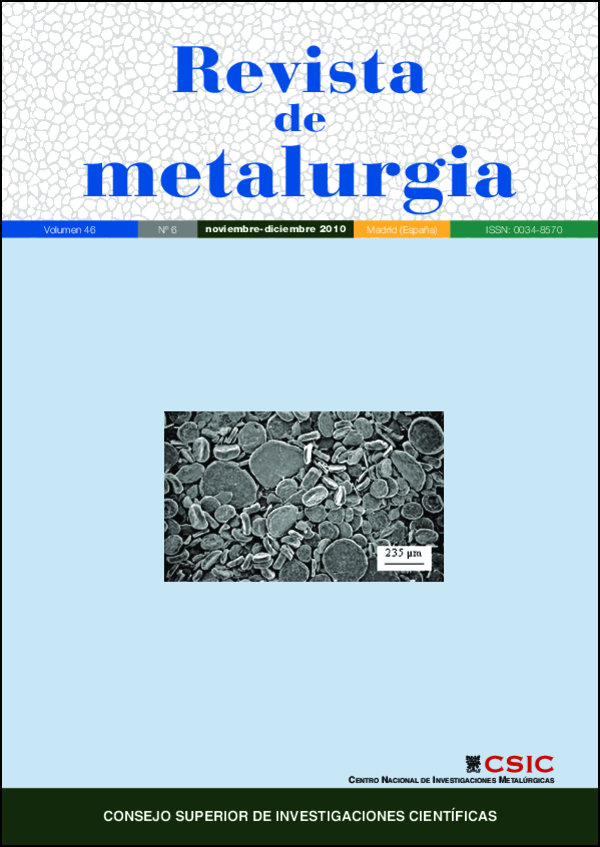Influence of cobalt and chromium additions on the precipitation processes in a Cu-4Ti alloys
DOI:
https://doi.org/10.3989/revmetalmadrid.1042Keywords:
Copper, Cu-Ti, Precipitation, MicrocalorimetryAbstract
The influence of 0.5 % atomic cobalt and 1 % atomic chromium additions on the precipitation hardening of Cu-4Ti alloy was studied by differential scanning calorimetry (DSC) and microhardeness measurements. The analysis of the calorimetric curves, for binary alloy, shows the presence of two overlapping exothermic reactions (stages 1 and 2) attributed to the formation of Cu4Ti and Cu3Ti particles in the copper matrix, respectively. DSC curves for Cu-4Ti-0,5Co alloy shows three exothermic effects (overlapping stages 3 and 4 and stage 5) associated to the formation of phases Ti2Co, TiCo and Cu4Ti, respectively. DSC curves for Cu-4Ti-1Cr alloy shows three exothermic reactions (stages 6, 7 and 9) and one endothermic peak (stage 8). The exothermic reactions correspond to the formation of phases Cr2Ti, Cu4Ti and Cu3Ti, respectively, and the endothermic reaction are attributed to the Cr2Ti dissolution. The activation energies calculated using the modified Kissinger method were lower than the ones corresponding to diffusion of cobalt, chromium and titanium in copper. Kinetic parameters were obtained by a convolution method based on the Johnson-Mehl-Avrami (JMA) formalism.Microhardness measurements confirmed the formation of the mentioned phases. Also, these measurements confirmed the effect of cobalt and chromium addition on the binary alloy hardness.
Downloads
References
[1] T. Radelic, V. Radmilovic y W.A. Soffa, Acta Metall. 40 (1999) 845-852.
[2] T. Abbas y A.B. Ziya, J. Mater. Sci. 28 (1993) 5.010-5.013.
[3] D.E. Laughlin y J.W. Cahn, Acta Metall. 23 (1975) 329-339. doi:10.1016/0001-6160(75)90125-X
[4] A.A. Hameda y L. Blaz,Mater. Sci. Eng. A. 254 (1998) 83-89. doi:10.1016/S0921-5093(98)00753-9
[5] S. Nagarjuna, K. Balasubramanian y D.S. Sarma, J. Mater. Sci. 34 (1999) 2.929-2.942. [6] S. Nagarjuna y D.S. Sarma, Scripta Mater. 41 (1999) 359-363. doi:10.1016/S1359-6462(99)00187-6
[7] S. Nagarjuna,M. Srinivas, K. Balasubramanian y D.S. Sarma, Mater. Sci. Eng. A, 259 (1999) 34-42. doi:10.1016/S0921-5093(98)00882-X
[8] I.S. Batra,Mater. Sci. Eng. A, 360 (2003) 220- 227. doi:10.1016/S0921-5093(03)00440-4
[9] S. Suzuki, K. Hirabayashi, H. Shibata, K. Mimura, M. Isshiki y Y. Waseda, Scripta Mater. (2003) 431-435. doi:10.1016/S1359-6462(02)00441-4
[10] F. Hernandez, N. Cayetano, V.M. Lopez, H.J. Dorantes y J. de Jesús Cruz, Mater. Trans. 45 (2004) 2312-2315. doi:10.2320/matertrans.45.2312
[11] W.A. Soffa y D.E. Laughlin, ProgressMater. Sci. 49 (2004) 347-366.
[12] W. Piotrowski y Z. Gawrouski,Metals. Tech. 12 (1980) 502-510.
[13] E. Donoso, Rev. Metal. Madrid 44 (2008) 513- 520.
[14] D. Bozic y M. Miitkov, Mater. Sci. Techn. 8 (1992) 1.108-1.116.
[15] S. Nagarjuna, y D.S. Sarma, J. Mater. Sci. 37 (2002) 1.929-1.940.
[16] S. Nagarjuna, K.K. Sharma, I. Sudhakar y D.S.Sarma,Mater.Sci.Eng.A,313(2001)251-260. [17] I.S. Batra, A. Laik, G.B. Kale. G.K. Dey y U.D. Kulkarni,Mater. Sci. Eng. A, 402 (2005) 118-125.
[18] R. Markandeya, S. Nagarjuna y D.S. Sarma, J. Mater. Sci. 39 (2004) 1.579-1.587.
[19] R. Markandeya, S. Nagarjuna y D.S. Sarma, J. Mater. Sci. 41 (2006) 1.165.
[20] R. Markandeya, S. Nagarjuna y D.S. Sarma, Mater. Sci. Eng. A, 371 (2004) 291-305. doi:10.1016/j.msea.2003.12.002
[21] R. Markandeya, S. Nagarjuna y D.S. Sarma, Mater. Charact. 57 (2006) 348-357. doi:10.1016/j.matchar.2006.02.017
[22] R. Markandeya, S. Nagarjuna y D.S. Sarma, Mater. Sci. Eng. A, 404 (2005) 305-313. doi:10.1016/j.msea.2005.05.072
[23] A. Varschavsky y E. Donoso, J. Termal Anal. Cal. 68 (2002) 231-241.
[24] A.Varschavsky y E. Donoso, Mater. Lett., 57 (2003) 1.266-1.271.
[25] A. Varschavsky y E. Donoso, Mater. Sci. Eng. A, 145 (1991) 95-107. doi:10.1016/0921-5093(91)90299-3
[26] E.J. Mittemeijer, L. Cheng, P.J. Van der Shaaf, C.M. Brakman y B.M. Korevaar,Metall. Trans. A. 19 (1988) 925-932. doi:10.1007/BF02628377
[27] A.M. Brown y M.F. Ashby, Acta Metall. 28 (1980) 1.085-1.101.
[28] T. Ozawa, J. Thermal Anal. 9 (1976) 369-373. [29] A. Borrego y G. González-Dorcel, Mater. Sci. Eng. A. 276 (2000) 292-295.
[30] A. Varschavsky y E. Donoso, Mater. Lett. 57 (2003) 1.266-1.271.
[31] J.W. Christian, The theory of transformation of metal and alloys, Pergamon Press, 1975 Oxford, pp. 540-542.
Downloads
Published
How to Cite
Issue
Section
License
Copyright (c) 2010 Consejo Superior de Investigaciones Científicas (CSIC)

This work is licensed under a Creative Commons Attribution 4.0 International License.
© CSIC. Manuscripts published in both the printed and online versions of this Journal are the property of Consejo Superior de Investigaciones Científicas, and quoting this source is a requirement for any partial or full reproduction.
All contents of this electronic edition, except where otherwise noted, are distributed under a “Creative Commons Attribution 4.0 International” (CC BY 4.0) License. You may read the basic information and the legal text of the license. The indication of the CC BY 4.0 License must be expressly stated in this way when necessary.
Self-archiving in repositories, personal webpages or similar, of any version other than the published by the Editor, is not allowed.
















